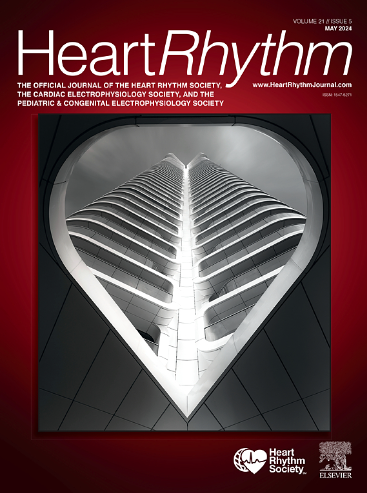经导管左心耳闭塞的SCAI/HRS技术综述。
IF 5.7
2区 医学
Q1 CARDIAC & CARDIOVASCULAR SYSTEMS
引用次数: 0
摘要
背景:非瓣膜性心房颤动(NVAF)与左心房附件血栓形成导致卒中风险增加相关,超过90%的血栓起源于左心房附件。虽然口服抗凝剂(OAC)是预防中风的标准治疗方法,但由于出血风险,许多患者不能长期服用OAC。经皮左心耳闭塞术(LAAO)已成为另一种治疗策略。尽管它被迅速采用,但在临床实践中,在患者选择、成像技术、手术指导和术后管理方面存在着实质性的差异。本系统综述旨在收集和综合证据,为新的心血管血管造影与干预学会(SCAI)和心律学会(HRS) LAAO指南的制定提供信息。方法:我们检索PubMed, Embase和Cochrane图书馆从成立到2024年1月5日,关于经皮LAAO手术的研究。符合条件的研究是在接受LAAO的成人非瓣膜性房颤患者中进行的,或者在闭塞手术后出现器械周围泄漏或器械相关血栓。排除了外科LAAO、双装置或联合程序以及目前未在美国上市的装置的研究。数据从重复的研究中提取,并使用荟萃分析和叙事综合进行总结。偏倚风险(RoB)的评估采用非随机干预研究的RoB工具和Cochrane随机试验的RoB工具2版(RoB 2.0)。证据的总体确定性采用分级建议评估、发展和评价(GRADE)方法进行评估。结果:我们检索了3769篇标题和摘要,其中27篇研究符合资格标准,并为分析提供了数据。数据被提取出来,以解决LAAO对非瓣瓣性房颤患者卒中预防的结果,与OAC相比,无治疗,各种方法包括术前成像,术中指导和术后抗血栓治疗方案。结论:对于有出血风险的非瓣膜性房颤患者,左心耳闭塞术是预防卒中的有效选择,但在影像学策略和术后处理方面仍存在不确定性。本文章由计算机程序翻译,如有差异,请以英文原文为准。
SCAI/HRS technical review on transcatheter left atrial appendage occlusion
Background
Nonvalvular atrial fibrillation (NVAF) is associated with an increased risk of stroke due to thrombus formation in the left atrial appendage, where over 90% of thrombi originate. While oral anticoagulation (OAC) is the standard therapy for stroke prevention, many patients cannot tolerate long-term OAC due to bleeding risks. Percutaneous left atrial appendage occlusion (LAAO) has emerged as an alternative strategy. Despite its rapid adoption, substantial variability exists in clinical practice regarding patient selection, imaging techniques, procedural guidance, and postprocedural management. This systematic review aims to collect and synthesize evidence to inform the development of new Society for Cardiovascular Angiography & Interventions and the Heart Rhythm Society guidelines on LAAO.
Methods
We searched PubMed, Embase, and Cochrane Library from inception through January 5, 2024, for studies of the percutaneous LAAO procedure. Eligible studies were conducted in adults with NVAF undergoing LAAO, or with peridevice leak or device-related thrombus after an occlusion procedure. Studies of surgical LAAO, double device or combined procedures, and devices that are not currently marketed in the United States were excluded. Data were extracted from studies in duplicate and summarized using meta-analysis and narrative synthesis. Risk of bias (RoB) was assessed using the RoB in nonrandomized studies of interventions tool, and version 2 of the Cochrane RoB tool for randomized trials (RoB 2.0). Overall certainty of evidence was assessed using the Grading of Recommendations Assessment, Development, and Evaluation approach.
Results
Our search identified 3769 titles and abstracts, of which 27 studies met eligibility criteria and contributed data to the analysis. Data were abstracted to address outcomes of LAAO for stroke prevention in patients with NVAF, in comparison to OAC, no therapy, and across various approaches including preprocedure imaging, intraprocedure guidance, and postprocedure antithrombotic regimens.
Conclusions
Left atrial appendage occlusion is an effective alternative to OAC for stroke prevention in NVAF patients with bleeding risks, but uncertainties remain regarding imaging strategies and postprocedural management.
求助全文
通过发布文献求助,成功后即可免费获取论文全文。
去求助
来源期刊

Heart rhythm
医学-心血管系统
CiteScore
10.50
自引率
5.50%
发文量
1465
审稿时长
24 days
期刊介绍:
HeartRhythm, the official Journal of the Heart Rhythm Society and the Cardiac Electrophysiology Society, is a unique journal for fundamental discovery and clinical applicability.
HeartRhythm integrates the entire cardiac electrophysiology (EP) community from basic and clinical academic researchers, private practitioners, engineers, allied professionals, industry, and trainees, all of whom are vital and interdependent members of our EP community.
The Heart Rhythm Society is the international leader in science, education, and advocacy for cardiac arrhythmia professionals and patients, and the primary information resource on heart rhythm disorders. Its mission is to improve the care of patients by promoting research, education, and optimal health care policies and standards.
 求助内容:
求助内容: 应助结果提醒方式:
应助结果提醒方式:


